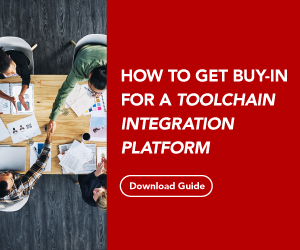
In today’s fast-paced software development landscape, the race to streamline workflows, reduce waste, optimize processes, and boost collaboration is more urgent than ever. That’s where value stream integration solutions play a pivotal role, promising immediate end-to-end visibility, highly efficient operations, and the power to make data-driven decisions.
However, organizations often face a crucial decision: should they build a custom value stream integration solution in-house or invest in a pre-built one? Let’s explore the intricacies of this decision-making process, evaluating the advantages and disadvantages of each option and understanding the scenarios in which investing in a ready-made commercial solution is most beneficial.
The Urgent Need for Automated Value Stream Integration
Before delving into the build-vs-buy dilemma, it’s essential to understand the significance of value stream Integration. In today’s rapidly evolving, highly competitive business landscape, the ability to get to market and deliver value to customers quickly and efficiently can make or break an organization.
Value stream integration involves the seamless flow of information and work across the entire software development lifecycle. It spans multiple teams, tools, and processes, from ideation and planning to development, testing, deployment, and monitoring.
The benefits of value stream integration include:
- Reduced Waste: Bottlenecks, redundant tasks, and delays in the software development process are minimized.
- Enhanced Collaboration: Communication and cooperation among cross-functional teams, vital for agile development, is easily facilitated.
- Better Decision-Making: Real-time insights into the delivery progress are accessible, enabling data-driven decisions.
- Faster Time-to-Market: Delivering valuable software features and updates to end-users is accelerated.
Building vs Buying Value Stream Integration Software
Building your own value stream integration software can be a compelling proposition for many organizations, driven by specific needs, goals, and circumstances. This strategic decision often arises from a desire for greater control, tailored solutions, or unique capabilities that can’t be easily achieved with off-the-shelf options.
Advantages of Building In-House
Building in-house software can offer a range of advantages for those with the resources, expertise, and long-term vision to undertake such an endeavor. Benefits include:
Full Control
One of the most significant advantages of building in-house is having complete control over the development process. This means that you can tailor the solution to specifically meet your organization’s unique needs. Customization can be especially appealing if your organization has highly specialized workflows or requirements.
Integration Flexibility
Building your solution from scratch allows you to design integrations with existing tools and systems. This can be a significant advantage if your organization uses a unique combination of tools that might not be well-supported by off-the-shelf solutions.
Challenges of Building In-House
On the other hand, building a custom value stream integration solution presents its own set of challenges that organizations might be hesitant to take on:
Development Costs
Developing and maintaining an in-house solution can be costly. This includes hiring skilled developers, dedicating resources to development, and ongoing maintenance. The costs can quickly add up, potentially exceeding the price of a pre-built solution.
Time-to-Market
Building a custom solution takes time. From initial development to testing and deployment, the overall process can be lengthy. This can delay your organization’s ability to realize the benefits and return on investment of the value stream integration.
Resource Intensiveness
Building a custom solution requires a dedicated team of developers, project managers, and quality assurance professionals. It can strain your organization’s resources and divert focus from core business objectives.
Advantages of Buying a Pre-Built Solution
Investing in a pre-built value stream integration solution like Planview Hub offers an array of compelling advantages for organizations:
Rapid Deployment
Pre-built solutions are ready to deploy, significantly reducing the time it takes to realize their benefits. This rapid deployment can help your organization quickly address integration challenges and improve collaboration.
Cost Predictability
With a pre-built solution, costs are typically more predictable. You have a clear understanding of the initial purchase costs, licensing fees, and ongoing maintenance expenses. This predictability can be invaluable for budget planning.
Vendor Support
Reputable vendors like Planview provide ongoing support, training, and updates for their solutions. This means your organization can rely on expert assistance when needed, reducing the burden on your internal IT team.
Scalability
Pre-built solutions are designed to scale with your organization’s needs. As your business grows and your integration requirements become more complex, these solutions can often adapt more easily than custom-built ones.
Considerations When Buying a Pre-Built Solution
While pre-built solutions offer many advantages, it’s essential to consider your organization’s specific needs and goals. Ensure that the solution you choose aligns with your workflows, existing tech stack, and business objectives.
Compatibility with existing systems
Ensuring seamless compatibility with the organization’s current software and technology is challenging. Misalignments can result in costly workarounds or system replacements that may not fit the budget or strategic timeline.
Data security and privacy
Trusting a third party with sensitive data can raise security and privacy concerns. Organizations must assess the vendor’s security measures and compliance standards while considering legal and regulatory implications.
Scalability
As business needs evolve, scaling a pre-built solution to accommodate growth and changing requirements may present obstacles. The solution should be able to accommodate increased data volumes, additional integrations, and evolving requirements without causing performance bottlenecks or system limitations.
Maintenance and support
Relying on the vendor for updates, bug fixes, and technical support may lead to disruptions if the vendor’s service level is inadequate. Evaluate the vendor’s reputation for responsiveness, SLAs, and ongoing maintenance.
Your Path to Optimized Value Stream Integration
The decision between building and buying a software value stream integration solution is a critical one and will have a long-term impact on an organization. While building may offer control and customization, it often comes with higher costs and a longer time-to-market. Buying a pre-built solution like Planview Hub enables an organization to deploy rapidly, have cost predictability, and gain access to expert support.
Planview Hub is a proven solution that streamlines your value stream integration. With a focus on end-to-end visibility, Planview Hub empowers organizations to make data-driven decisions, achieve greater efficiency, and optimize their software development processes. Learn how industry-leading organizations like BMW and Accenture or watch this demo to see how Planview Hub can help streamline your software delivery.




